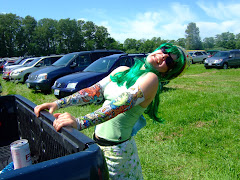 have a huge aversion to cleaning house, although there are usually other things I'd rather be doing, like napping or reading or having a Modern Family marathon. Calculating the numer of Weight Watchers Points I'll earn by working up a sweat cleaning the hair out of the drain in the boys' bathroom never serves as adequate inspiration, so I've taken to watching episodes of Hoarders online. It's reassuring to know that I'm nowhere near pathological hoarding, and the filth in the houses they feature motivates me to keep ahead of the grime, even if I will never conquer the endless tumbleweeds of dog hair that seem to regenerate themselves every time I put the broom away.
have a huge aversion to cleaning house, although there are usually other things I'd rather be doing, like napping or reading or having a Modern Family marathon. Calculating the numer of Weight Watchers Points I'll earn by working up a sweat cleaning the hair out of the drain in the boys' bathroom never serves as adequate inspiration, so I've taken to watching episodes of Hoarders online. It's reassuring to know that I'm nowhere near pathological hoarding, and the filth in the houses they feature motivates me to keep ahead of the grime, even if I will never conquer the endless tumbleweeds of dog hair that seem to regenerate themselves every time I put the broom away.There is some sensationalism to the TV program Hoarders, which focuses on two stories of hoarding per episode, complete with lots of footage of the hoarders' homes and lots of emotional moments wherein family members confront the hoarders or the hoarders work with therapists to confront their issues. In Stuff: Compulsive Hoarding and the Meaning of Things, authors Randy O. Frost and Gail Steketee examine the causes of hoarding, as well as the manifestations of the disorder and treatment. Like the TV show, the authors of Stuff use fascinating, bizarre case studies of real people to illustrate the ways the disorder presents itself. If you enjoy watching Hoaders, you'll enjoy reading more details about the way the disorder affects their lives.
I was intrigued by the statistics: between 2 and 5 % of the American population--about 6-15 MILLION people--suffer from some sort of hoarding disorder. That's a lot of very messy houses, whether they are stuffed with hoarded food, pets, or broken lawnmowers. And contrary to what some folks believe, hoarding doesn't just afflict people in places where there is an excess of consumerism or available products--hoarding has been found all over the globe. In addition, hoarding isn't determined by how much stuff a person has, but by how that stuff affects the quality of their lives. When it impairs one's ability to perform basic functions, it's considered pathological. In some of these cases, living conditions threaten the health of the hoarder and other occupants, and can even be deadly. One of the most famous hoarders in history, Langley Collyer, lived in squalor with his brother Homer for years (this despite their monetary wealth). Eventually, the extensive collection of junk (and numerous booby traps) led to both of their deaths.
Most of the scenarios on the TV show Hoarders end with some success--psychologists work with the hoarder and his or her family, 1-800-GOT-JUNK shows up with a cleaning team, and order is established. But as follow-ups on the TV show illustrate, hoarding is an extremely difficult disorder to treat, owing mainly to its deeply rooted causes, and the cases on TV rarely reflect the many years of continual therapy required for hoarders to escape their habits and live less cluttered lives.
This is among a number of intriguing books of applied psychology books I've read that I would recommend to others. It's highly readable, adn the individual cases of hoarding are fascinating, but their analysis goes beyong mere voyeurism and offers substantial insight into an affliction that has only recently begun to be revealed and examined.
